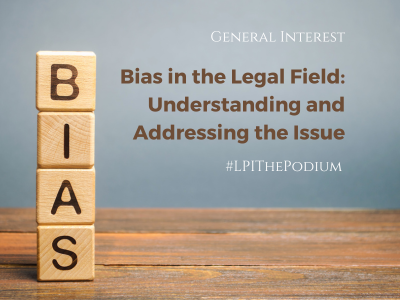
The legal field is meant to be a place where justice is served impartially, where the law is applied without bias or discrimination. Unfortunately, bias in the legal field is a pervasive issue that can have significant consequences for individuals and communities. In this article, we will explore the different types of bias that exist in the legal field and some strategies to address and mitigate them.
Types of Bias in the Legal Field
- Implicit Bias: Implicit bias refers to unconscious attitudes and stereotypes that affect our actions and decisions. Implicit biases can be based on race, gender, sexual orientation, socioeconomic status, and other characteristics. These biases can impact how lawyers interact with clients, witnesses, judges, and other legal professionals, leading to unfair treatment and unequal outcomes.
- Confirmation Bias: Confirmation bias occurs when lawyers seek out information that confirms their pre-existing beliefs or assumptions while ignoring evidence that contradicts them. This can lead to flawed legal arguments, biased decisions, and an unfair outcome.
- Stereotyping: Stereotyping refers to the generalization of certain characteristics and behaviors to a whole group of people. This can lead to assumptions about individuals based on their race, gender, sexual orientation, or other characteristics, which can impact how they are treated by the legal system.
- Structural Bias: Structural bias refers to policies, practices, and institutional arrangements that perpetuate systemic inequities. For example, the lack of diversity in the legal profession can contribute to structural bias, as it can lead to a lack of understanding and empathy for marginalized communities.
Strategies to Address Bias in the Legal Field
- Education and Awareness: Legal professionals need to be trained to recognize their own biases and how they impact their decision-making. This can involve workshops, seminars, and diversity and inclusion training programs.
- Diversify the Legal Profession: Increasing the diversity of legal professionals can help to address structural bias and promote a more equitable legal system. This can involve initiatives to recruit, retain, and promote lawyers from underrepresented communities.
- Implement Bias-Reducing Practices: Legal professionals can take steps to mitigate the impact of bias on their decision-making. For example, blind resume screening can reduce the impact of implicit bias in the hiring process, and standardized guidelines can ensure that decisions are made based on objective criteria.
- Engage in Continuous Self-Reflection: Lawyers should engage in continuous self-reflection to identify and address their own biases. This can involve seeking feedback from colleagues, reflecting on past decisions, and being open to learning from others.
Conclusion
Bias in the legal field is a complex issue that requires a multifaceted approach to address. Legal professionals must recognize and address their own biases, work to increase diversity in the legal profession and implement bias-reducing practices. By taking these steps, we can promote a more just and equitable legal system that serves all members of our society.
Categorized in: General
| << previous | next >> |








